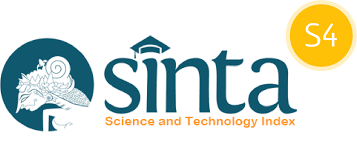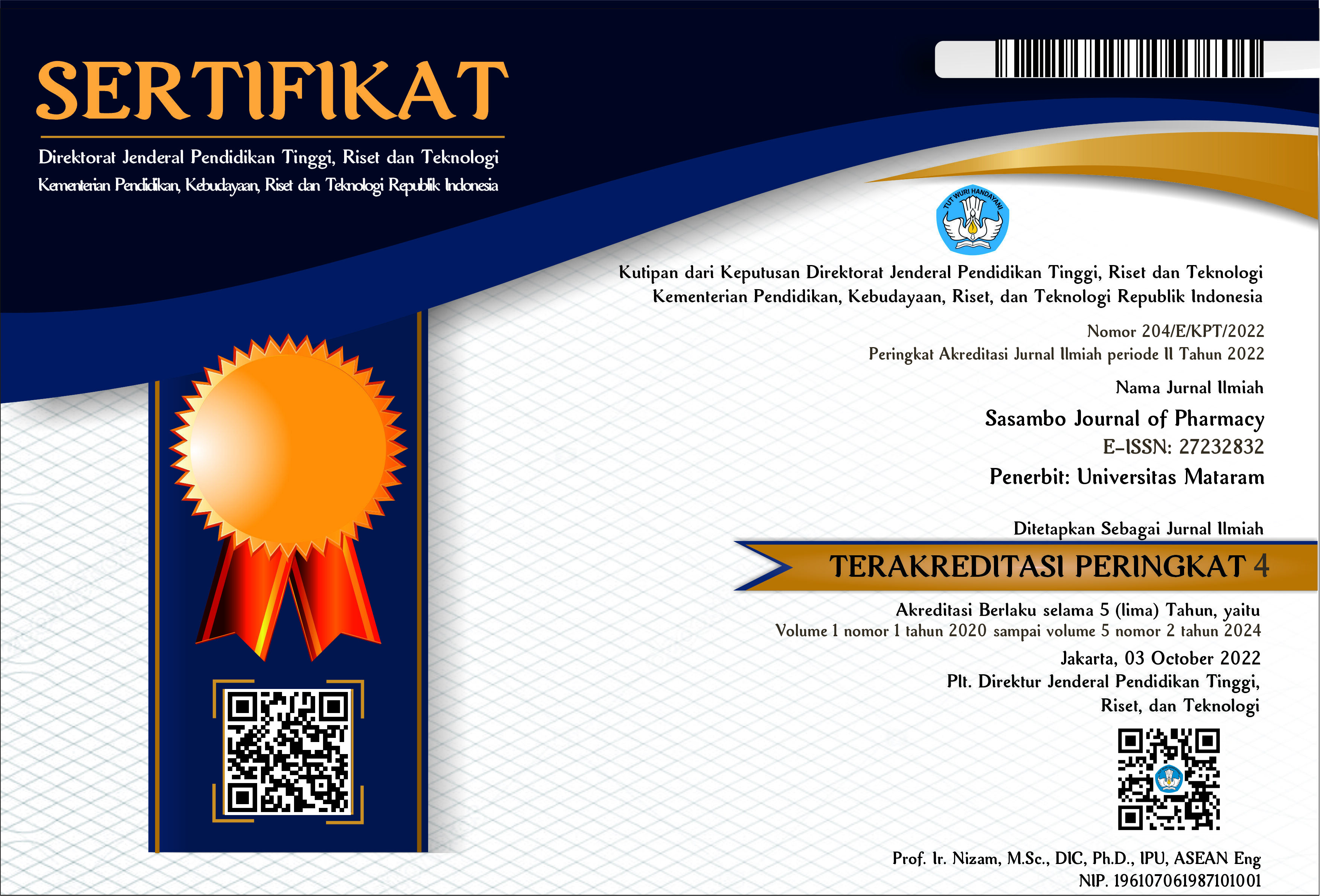Sugar content evaluation in commercially available lidah kucing pastries: uv-vis spectrophotometric analysis of traditional indonesian confections in pontianak tenggara district
DOI:
10.29303/sjp.v6i2.632Downloads
Abstract
Glucose content in confectionery products requires careful monitoring due to its association with serious health conditions including obesity, diabetes, and cardiovascular disease. This study examined glucose levels in three lidah kucing cookie samples from Pontianak Tenggara district retailers to assess nutritional variability in these traditional Indonesian confections. The research employed a dual analytical approach combining qualitative and quantitative methods. Initial screening utilized Fehling and Benedict reagent tests to confirm glucose presence, followed by precise quantitative analysis using the Nelson-Somogyi method with UV-visible spectrophotometry. The quantitative protocol involved standard solution preparation, calibration curve development, optimal wavelength determination, and triplicate sample measurements to ensure analytical reliability. Qualitative testing confirmed glucose presence in all three samples through positive Fehling and Benedict reactions. Quantitative analysis revealed significant concentration variations among products. Sample A contained 0.227 percent glucose, Sample B demonstrated substantially higher levels at 0.993 percent, while Sample C showed minimal glucose content at 0.004 percent. These results indicate considerable variability in glucose concentrations across commercially available lidah kucing products within the study area. The investigation successfully established glucose presence in all examined samples while documenting substantial differences in glucose concentrations among similar commercial products. These findings highlight the importance of analytical monitoring in traditional confectionery items and demonstrate significant nutritional variation among comparable products in local markets. The results provide essential baseline data for consumer awareness and potential regulatory considerations regarding glucose content in traditional Indonesian baked goods, supporting informed dietary choices and public health initiatives.
Keywords:
Glucose, lidah kucing cakes, spectrophotometry UV-VisibleReferences
Akyüz, E., Başkan, K. S., Tütem, E., & Apak, R. (2021). High performance liquid chromatographic method with post-column detection for quantification of reducing sugars in foods. Journal of Chromatography A, 1660, 462664. https://doi.org/https://doi.org/10.1016/j.chroma.2021.462664
Chan, R., Sidoretno, W. M., & Lestari, R. (2023). Penetapan Kadar Amilosa Pada Mi Sagu Secara Spektrofotometri Uv-Vis. Jurnal Farmasi, 1(1),12-18.
Lee, J., Roux, S., Le Roux, E., Keller, S., Rega, B., & Bonazzi, C. (2022). Unravelling caramelization and Maillard reactions in glucose and glucose + leucine model cakes: Formation and degradation kinetics of precursors, α-dicarbonyl intermediates and furanic compounds during baking. Food Chemistry, 376, 131917. https://doi.org/https://doi.org/10.1016/j.foodchem.2021.131917
Mabood, F., Hussain, Z., Haq, H., Arian, M. B., Boqué, R., Khan, K. M., Hussain, K., Jabeen, F., Hussain, J., Ahmed, M., Alharasi, A., Naureen, Z., Hussain, H., Khan, A., & Perveen, S. (2016). Development of new UV–vis spectroscopic microwave-assisted method for determination of glucose in pharmaceutical samples. Spectrochimica Acta Part A: Molecular and Biomolecular Spectroscopy, 153, 212–215. https://doi.org/https://doi.org/10.1016/j.saa.2015.08.035
Manik, M. E., & Herlinawati, H. (2021). Analysis of the Utilization of VCO as A Glucose Level Reducing Material in Brown Rice Using A UV-VIS Spectrophotometer. Indonesian Journal of Chemical Science and Technology, 4(1), 11–14. https://doi.org/10.24114/ijcst.v4i1.23089
Mawlong, I., Sujith Kumar, M. S., Gurung, B., Singh, K. H., & Singh, D. (2017). A simple spectrophotometric method for estimating total glucosinolates in mustard de-oiled cake. International Journal of Food Properties, 20(12), 3274–3281. https://doi.org/10.1080/10942912.2017.1286353
Nunes, A., Azevedo, G. Z., dos Santos, B. R., Lima, G. P. P., Moura, S., & Maraschin, M. (2024). Application of UV–vis spectrophotometry and chemometrics to investigate adulteration by glucose syrup in Brazilian polyfloral honey. Food and Humanity, 2, 100194. https://doi.org/https://doi.org/10.1016/j.foohum.2023.12.002
Putri, R. P., Sulistyawati, A., Tanius, B., Kuliner, S., & Bali, I. (2022). Dekonstruksi Kue Khas Kalimantan Menjadi Western Dessert. Journey: Journal of Tourismpreneurship, Culinary, Hospitality, Convention and Event Management 5, 33–40.
Rahmayani, A., Marzuki, A., & Anindito Sri Tunjung, W. (2024). Validasi Metode Analisa Penetapan Kadar Glukosa dengan Metode Dubois secara Spektrofotometri Validation Analytical Method of Glucose Assay using Dubois Method with spectrophotometry. Majalah Farmaseutik, 490(4), 2024. https://doi.org/10.22146/farmaseutik.v20i4.97119
Sahu, S., Pandey, R. K., Shukla, S. S., & Gidwani, B. (2024). Spectrophotometric Method Development and Validation of Empagliflozin in Active Pharmaceutical Ingredient and Tablet Dosage Form. Journal of Applied Spectroscopy, 91(2), 405–410. https://doi.org/10.1007/s10812-024-01734-8
Sun, Y., Zhong, C., Zhou, Z., Lei, Z., & Langrish, T. A. G. (2022). A Review of In Vitro Methods for Measuring the Glycemic Index of Single Foods: Understanding the Interaction of Mass Transfer and Reaction Engineering by Dimensional Analysis. Processes, 10(4), 759. https://doi.org/10.3390/pr10040759
License
Copyright (c) 2025 The Author(s)

This work is licensed under a Creative Commons Attribution 4.0 International License.
Authors who publish with Sasambo Journal of Pharmacy (SJP), agree to the following terms:
- Authors retain copyright and grant the journal right of first publication with the work simultaneously licensed under a Lisensi Creative Commons Atribusi 4.0 Internasional. This license allows authors to use all articles, data sets, graphics and appendices in data mining applications, search engines, web sites, blogs, and other platforms by providing an appropriate reference. The journal allows the author(s) to hold the copyright without restrictions and will retain publishing rights without restrictions.
- Authors are able to enter into separate, additional contractual arrangements for the non-exclusive distribution of the journal's published version of the work (e.g., post it to an institutional repository or publish it in a book), with an acknowledgment of its initial publication in Sasambo Journal of Pharmacy
- Authors are permitted and encouraged to post their work online (e.g., in institutional repositories or on their website) prior to and during the submission process, as it can lead to productive exchanges, as well as earlier and greater citation of published work (See The Effect of Open Access).







